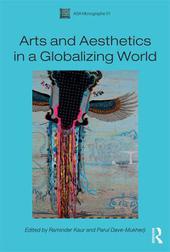
|
Arts and Aesthetics in a Globalizing World
Paperback / softback
Main Details
| Title |
Arts and Aesthetics in a Globalizing World
|
| Authors and Contributors |
Edited by Raminder Kaur
|
|
Edited by Parul Dave Mukherji
|
| Series | ASA Monographs |
|---|
| Physical Properties |
| Format:Paperback / softback | | Pages:310 | | Dimensions(mm): Height 234,Width 156 |
|
| ISBN/Barcode |
9781472519313
|
| Classifications | Dewey:306.47 |
|---|
| Audience | | Undergraduate | | Postgraduate, Research & Scholarly | |
|---|
|
Publishing Details |
| Publisher |
Bloomsbury Publishing PLC
|
| Imprint |
Bloomsbury Academic
|
| Publication Date |
21 May 2015 |
| Publication Country |
United Kingdom
|
Description
This is an investigation of arts and aesthetics in their widest senses and experiences, presenting a variety of perspectives which range from the metaphysical to the political. Moving beyond art as an expression of the inner mind and invention of the individual self, the volume bridges the gap between changing perceptions of contemporary art and aesthetics, and maps globalizing currents in a number of contexts and regions.The volume includes an impressive variety of case studies offered by established leaders in the field and original and emerging scholarly talent covering areas in India, Nepal, Indonesia, Iran, Russia, Rwanda, and Germany, as well as providing transnational or diasporic perspectives. From the contradictory demands made on successful artists from the south in the global art world such as Anish Kapoor, to images of war and puppetry created by female political prisoners, the volume compels creative and political interpretations of the ever-changing and globalizing terrain of arts and aesthetics.
Author Biography
Raminder Kaur is Professor of Anthropology and Cultural Studies in the School of Global Studies at the University of Sussex, UK.Parul Dave-Mukherji is Professor in the School of Arts and Aesthetics at Jawaharlal Nehru University, New Delhi, India.
Reviews[The book] undertakes an important and timely project ... [it] excels via its heterogeneous glimpses and its curated range of worldmaking activities: digital media, pirated media, the activation of smell within museum exhibits, the soundscapes of weddings, mimesis within political practices, performative practices of diasporic cultures, and alternative art spaces in Tehran. The diversity of its examples offers insight into the sensorial as a realm between individual and group identities. * Anthropos *
|